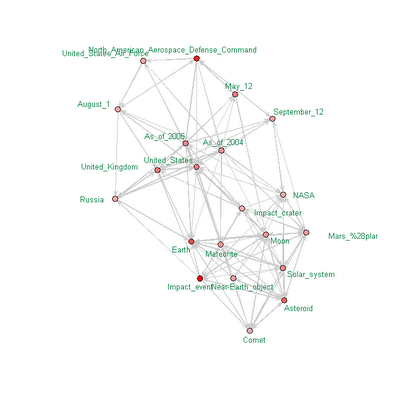The sky is falling (....maybe)
Two stories that came up today:
Small asteroid to fly by Earth without danger
Okay, so this may be an unfair juxtaposition. But in any case, I decided to do the Wikipedia network thingie I've been talking about. Below are two plots for the center of the network obtained by using the keywords Near-earth_object, NORAD, and Impact_event (45861 nodes and 131354 edges, pruned to 340 nodes and 12130 edges). The first shows the nodes that capture the upper 65% of the betweenness, the other captures the upper 80%. (The shading of the nodes is a new feature I introduced, representing the relative betweenness, darker colors representing higher betweenness scores.)


The appearance of May 12 in the middle of the network is easy to explain:
I'm treading here on Goro Adachi's territory, and I find myself wondering if this type of analysis can be used in the same way Goro uses his geodetic (and semiotic) analyses. Certainly, rather than becoming unhinged at the possibilities of various catastrophes, it's best to take Goro's dispassionate approach to the whole thing and try to learn what we can about the world and about ourselves.
For the record, I'm not pulling a Chicken Little/Cassandra here. I'm just pointing out two interesting stories and trying to see how memetic analysis can illuminate them.
Small asteroid to fly by Earth without danger
An asteroid will pass Earth at a very close distance in the predawn hours of Monday, astronomers reported on Friday, noting that there won't be any danger of collision.Colorado Springs Air Force installation on heightened alert
The asteroid, coded 2004 XP14, was first picked up in December 2004. It is believed to be 370 to 800 meters in diameter, according to astronomers with the Near Earth Object Program (NEO) of U.S. space agency NASA.
An Air Force installation in Colorado Springs and one near Denver are operating with heightened security.
The Cheyenne Mountain Air Station, which houses NORAD, is now at "Bravo-Plus".
There are five levels of alert: normal, Alpha (low), Bravo (medium), Charlie (high) and Delta (critical). “Bravo-Plus” is slightly higher than a medium threat level.
Okay, so this may be an unfair juxtaposition. But in any case, I decided to do the Wikipedia network thingie I've been talking about. Below are two plots for the center of the network obtained by using the keywords Near-earth_object, NORAD, and Impact_event (45861 nodes and 131354 edges, pruned to 340 nodes and 12130 edges). The first shows the nodes that capture the upper 65% of the betweenness, the other captures the upper 80%. (The shading of the nodes is a new feature I introduced, representing the relative betweenness, darker colors representing higher betweenness scores.)


The appearance of May 12 in the middle of the network is easy to explain:
During the 2006 return to perihelion, which for the main fragment C takes place on 2006 June 6 (just inside the Earth’s orbit), the comet began to fragment into more than 30 additional pieces. All of the observed fragments in 2006 will pass relatively close to the Earth during the interval May 12 through May 28 but none will pass closer than 5.5 million miles. These passages of the fragments past the Earth offer astronomers an excellent opportunity to examine the cometary breakup process and hopefully these observations will shed some light on just why some comets disrupt. Apparently some comets have very weak internal structures and perhaps rapid rotation or the pressure of vaporizing interior ices, as the comet approaches the warming sun, causes these breakup events.I couldn't find anything interesting about August 1 or September 12.
I'm treading here on Goro Adachi's territory, and I find myself wondering if this type of analysis can be used in the same way Goro uses his geodetic (and semiotic) analyses. Certainly, rather than becoming unhinged at the possibilities of various catastrophes, it's best to take Goro's dispassionate approach to the whole thing and try to learn what we can about the world and about ourselves.
For the record, I'm not pulling a Chicken Little/Cassandra here. I'm just pointing out two interesting stories and trying to see how memetic analysis can illuminate them.
Labels: experimental

0 Comments:
Post a Comment
<< Home